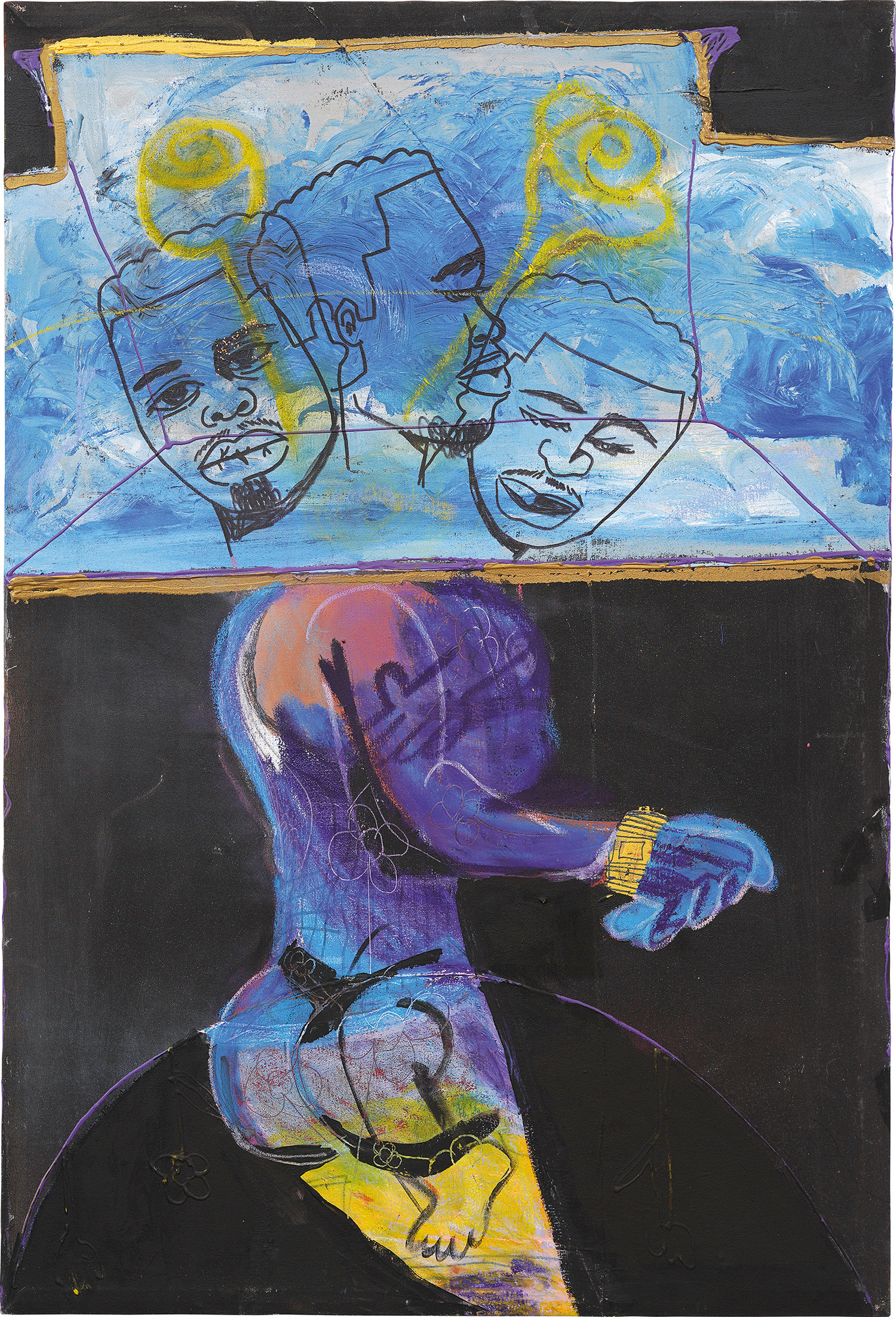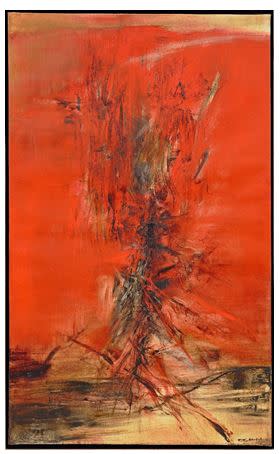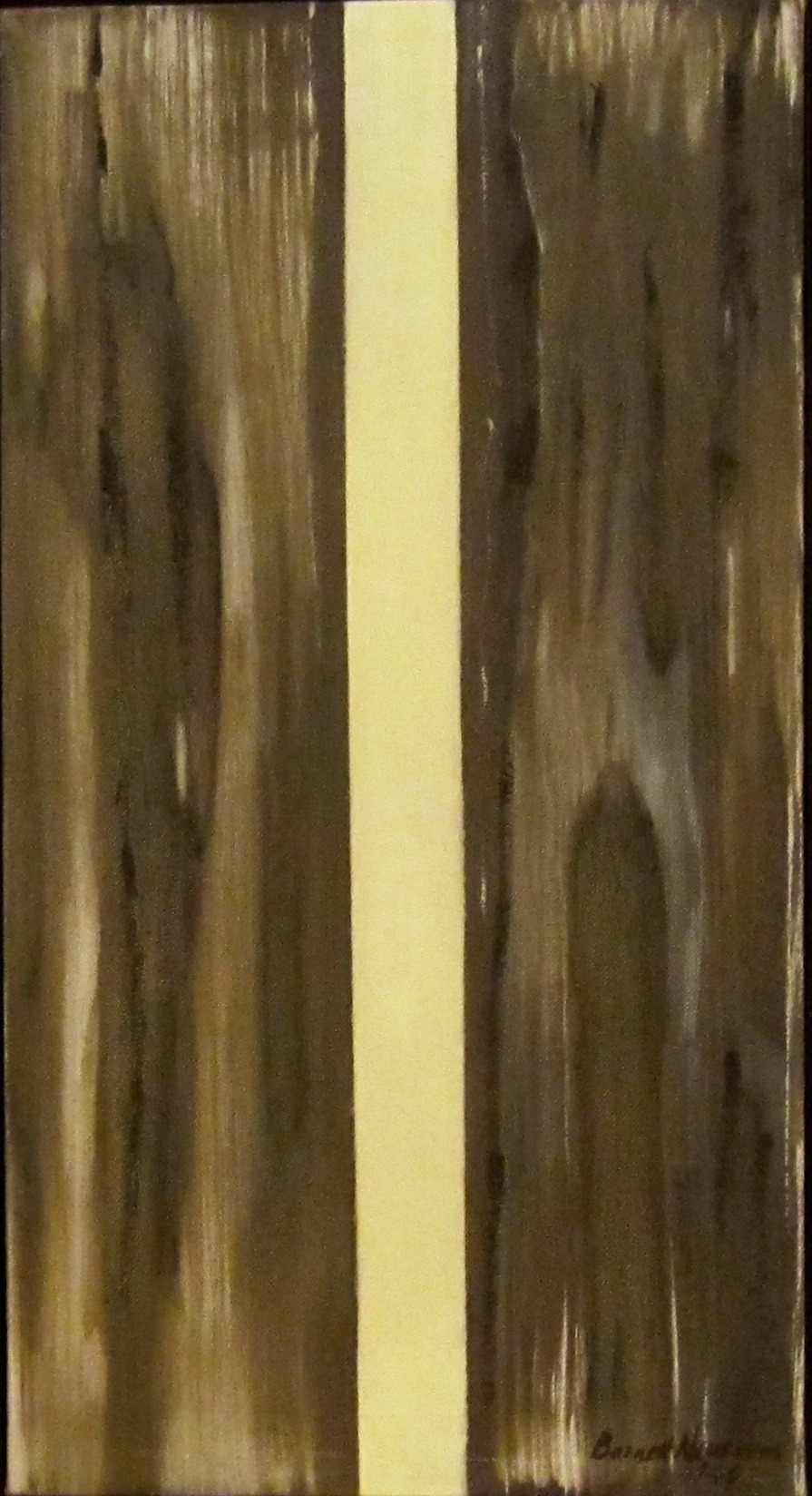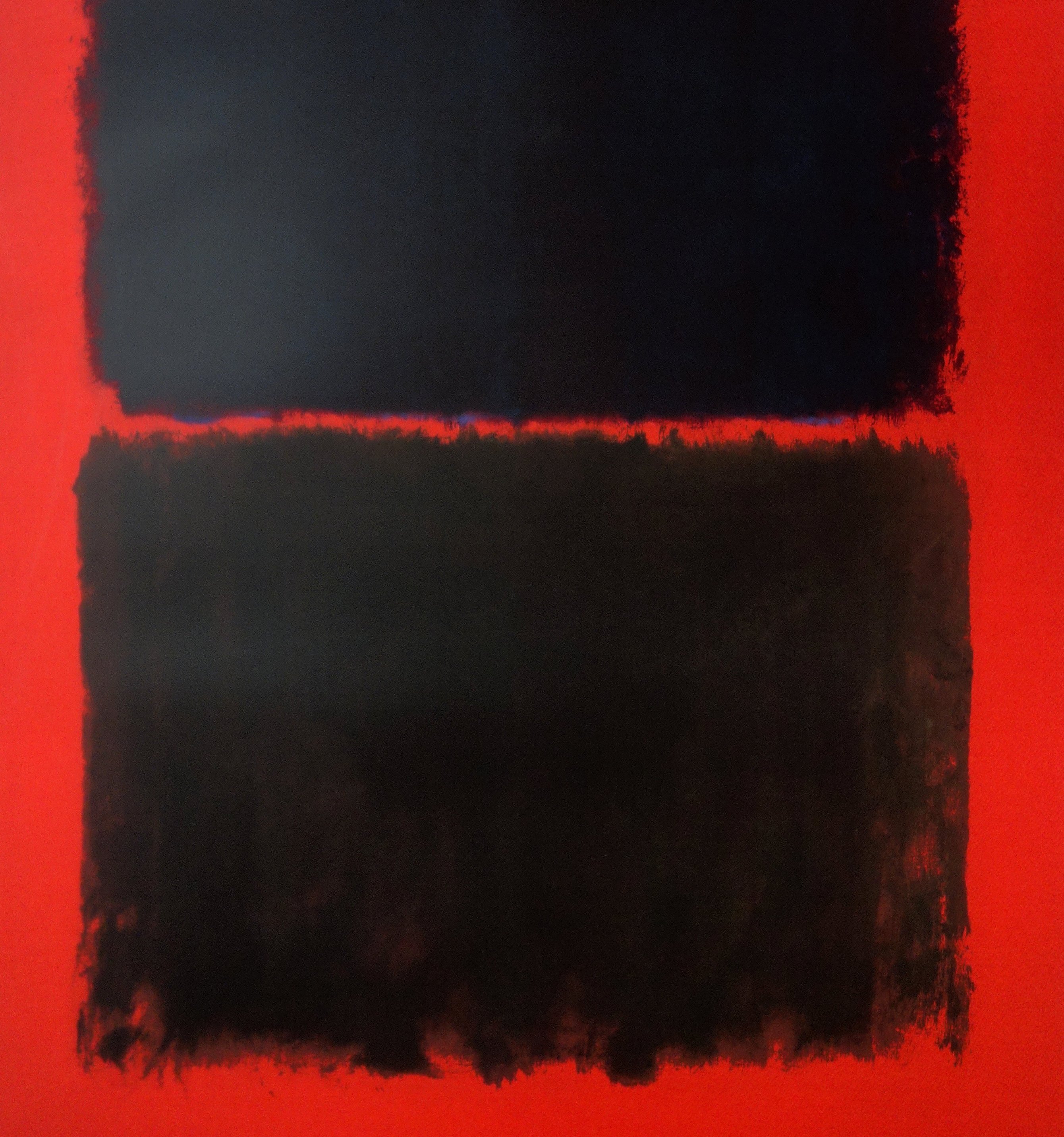

101
Jonathan Lyndon Chase
Hacate
signed and dated 'Jonathan L Chase 2017' on the reverse
glitter, acrylic, marker and graphite on canvas
88.9 x 61 cm. (35 x 24 in.)
Executed in 2017.
Full-Cataloguing
“In this period of stains without a subject, empty crownings of silent lyrical expression, Zao Wou-Ki’s painting is violently charged with meaning, with a weight of signs not without profusion. Signs no doubt indecipherable by the illiterate Westerner, but known to the artist.”
- René de Solier
Timeline
Zao Wou‐Ki, one of the most celebrated Chinese modern artists in the world, was born in Beijing and trained at the National School of Arts in Hangzhou under the tutelage of the pioneering modern Chinese painter Lin Fengmian. Zao's move to Paris as a young artist led to the development of a singular style which moved freely between Chinese calligraphy techniques and Western‐inspired abstract compositions, and the creation of works which demonstrated a profound affinity with both traditions. Enriched by his artistic encounters both in the East and West, Zao became the embodiment of his name, ‘Wou‐Ki’ – the artist with 'no limits'.

Zao Wou-Ki
24.10.63
oil on canvas
194 x 97 cm.
Painted in 1963, this work is to be accompanied by a certificate of authenticity issued by the Fondation Zao Wou-Ki.The Hurricane Period, the name given to Zao’s period of practice between 1959 and 1972, is considered the apex of his extraordinary career. Referencing the wild, flowing style of cursive calligraphy that characterised Zao’s works of this period, the Hurricane Period marked the culmination of Zao’s formative training in traditional Chinese techniques and transition towards a more grand and majestic style synthesising Chinese and Western styles as well as ancient and modern elements. In a symbolic break with the past, and determined to eschew figuration going forward, Zao decided in 1958 that he would no longer give a title to his works, only marking them with their date of creation. 22.6.63 and 24.10.63, both executed within a few months of each other at the peak of the Hurricane Period, are prime examples of this new transcendental abstraction, the result of Zao’s decisive break with his esoteric ‘oracle bone’ style in favour of a more primal rendering of a search for the origins of the universe ‐ one beyond the constraints of form. Only around 100 large panel‐sized works (above a French standard size 80) from Zao’s Hurricane Period have ever come to auction.
‘Return to my deepest origins’
Part of a generation of Chinese artists who went abroad in the 1940s in search of artistic inspiration, Paris proved to be the catalyst for Zao’s meteoric rise to international recognition. Settling into Parisian life, Zao gradually made a name for himself as an abstract gestural painter, befriending other Paris‐based artists such as Pierre Soulages and Joan Miró. Originally inspired by the Impressionists, he was particularly taken by the work of Paul Klee, the Swiss avant‐garde painter who explored the expressive potential of colour and its relationship to music, spirituality and folk art (see for example Zeichen in Gelb, 1937). Zao continued searching for new avenues for personal expression in his work, in particular embracing lyrical abstraction ‐ a harmonious, painterly form of abstract expressionism favoured by Soulages and Georges Mathieu, amongst others.

Zao Wou-Ki
22.6.63
oil on canvas
146 x 89 cm.
By the mid‐1950s Zao began to re‐incorporate Chinese influences more boldly into his work, at times substituting calligraphy for his previously loose and winding brushstrokes. Zao explained in a 1962 interview with the French magazine Preuves, ‘Although the influence of Paris is undeniable in all my training as an artist, I also wish to say that I have gradually rediscovered China.’ He added, ‘Paradoxically, perhaps, it is to Paris that I owe this return to my deepest origins.’ Zao’s debt to Chinese calligraphy was manifold, a fact he freely acknowledged: ‘Calligraphy is the original source and the only guide for my painting’ (Zao Wou‐Ki, adapted from unidentified newspaper clipping, Scrapbook II, 1953 – 1960, Archives Zao Wou‐Ki). Zao’s formative early mastery of Chinese ink and brush became the roots of his artistic voice, from the inclusion of Shang Dynasty oracle bone characters in his landscape paintings in the 1950s (see for example Ailleurs, 1955), to the development of his whirlwind gestural brushstrokes in the 1960s that resemble the Tang Dynasty calligraphers Zhang Xu and Su Huai’s kuang cao (‘wild cursive script’ – see for example [untitled comp by Zhang Xu]). The unusual vertical format of 22.6.63 and 24.10.63 harks back to traditional Chinese hanging scrolls, whilst Zao deploys the calligraphic method of feibai (‘flying white’), where a brush (traditionally steeped in ink) smudges across silk in order to create a sense of flight (see Elegant Rocks and Sparse Trees by Zhao Mengfu, which demonstrates this method). Also evident is the use of the cunfa technique (‘crack technique’) – employing a semi‐dry brush to leave subtly textured traces of ink across the surface of the paper or silk – which evokes the shadows and textures of nature itself.
- René de Solier
Timeline
Zao Wou‐Ki, one of the most celebrated Chinese modern artists in the world, was born in Beijing and trained at the National School of Arts in Hangzhou under the tutelage of the pioneering modern Chinese painter Lin Fengmian. Zao's move to Paris as a young artist led to the development of a singular style which moved freely between Chinese calligraphy techniques and Western‐inspired abstract compositions, and the creation of works which demonstrated a profound affinity with both traditions. Enriched by his artistic encounters both in the East and West, Zao became the embodiment of his name, ‘Wou‐Ki’ – the artist with 'no limits'.

Zao Wou-Ki
24.10.63
oil on canvas
194 x 97 cm.
Painted in 1963, this work is to be accompanied by a certificate of authenticity issued by the Fondation Zao Wou-Ki.The Hurricane Period, the name given to Zao’s period of practice between 1959 and 1972, is considered the apex of his extraordinary career. Referencing the wild, flowing style of cursive calligraphy that characterised Zao’s works of this period, the Hurricane Period marked the culmination of Zao’s formative training in traditional Chinese techniques and transition towards a more grand and majestic style synthesising Chinese and Western styles as well as ancient and modern elements. In a symbolic break with the past, and determined to eschew figuration going forward, Zao decided in 1958 that he would no longer give a title to his works, only marking them with their date of creation. 22.6.63 and 24.10.63, both executed within a few months of each other at the peak of the Hurricane Period, are prime examples of this new transcendental abstraction, the result of Zao’s decisive break with his esoteric ‘oracle bone’ style in favour of a more primal rendering of a search for the origins of the universe ‐ one beyond the constraints of form. Only around 100 large panel‐sized works (above a French standard size 80) from Zao’s Hurricane Period have ever come to auction.
‘Return to my deepest origins’
Part of a generation of Chinese artists who went abroad in the 1940s in search of artistic inspiration, Paris proved to be the catalyst for Zao’s meteoric rise to international recognition. Settling into Parisian life, Zao gradually made a name for himself as an abstract gestural painter, befriending other Paris‐based artists such as Pierre Soulages and Joan Miró. Originally inspired by the Impressionists, he was particularly taken by the work of Paul Klee, the Swiss avant‐garde painter who explored the expressive potential of colour and its relationship to music, spirituality and folk art (see for example Zeichen in Gelb, 1937). Zao continued searching for new avenues for personal expression in his work, in particular embracing lyrical abstraction ‐ a harmonious, painterly form of abstract expressionism favoured by Soulages and Georges Mathieu, amongst others.

Zao Wou-Ki
22.6.63
oil on canvas
146 x 89 cm.
By the mid‐1950s Zao began to re‐incorporate Chinese influences more boldly into his work, at times substituting calligraphy for his previously loose and winding brushstrokes. Zao explained in a 1962 interview with the French magazine Preuves, ‘Although the influence of Paris is undeniable in all my training as an artist, I also wish to say that I have gradually rediscovered China.’ He added, ‘Paradoxically, perhaps, it is to Paris that I owe this return to my deepest origins.’ Zao’s debt to Chinese calligraphy was manifold, a fact he freely acknowledged: ‘Calligraphy is the original source and the only guide for my painting’ (Zao Wou‐Ki, adapted from unidentified newspaper clipping, Scrapbook II, 1953 – 1960, Archives Zao Wou‐Ki). Zao’s formative early mastery of Chinese ink and brush became the roots of his artistic voice, from the inclusion of Shang Dynasty oracle bone characters in his landscape paintings in the 1950s (see for example Ailleurs, 1955), to the development of his whirlwind gestural brushstrokes in the 1960s that resemble the Tang Dynasty calligraphers Zhang Xu and Su Huai’s kuang cao (‘wild cursive script’ – see for example [untitled comp by Zhang Xu]). The unusual vertical format of 22.6.63 and 24.10.63 harks back to traditional Chinese hanging scrolls, whilst Zao deploys the calligraphic method of feibai (‘flying white’), where a brush (traditionally steeped in ink) smudges across silk in order to create a sense of flight (see Elegant Rocks and Sparse Trees by Zhao Mengfu, which demonstrates this method). Also evident is the use of the cunfa technique (‘crack technique’) – employing a semi‐dry brush to leave subtly textured traces of ink across the surface of the paper or silk – which evokes the shadows and textures of nature itself.


